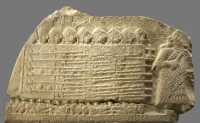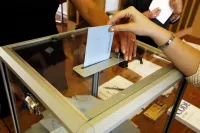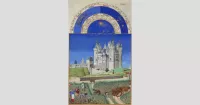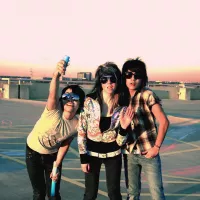Mallorca (Majorca) is the largest of the Balearic Islands, belonging to Spain. As the seventh-largest island in the Mediterranean Sea, it's a significant geographical and tourist destination.
1920: Publication of La estrella
In 1920, Jorge Luis Borges published his poem La estrella in the regional magazine Baleares.
1921: Publication of Catedral
In 1921, Jorge Luis Borges published his poem Catedral in the regional magazine Baleares. This poem expresses his admiration for the Cathedral of Palma.
1929: Joan Miró married Pilar Juncosa
In 1929, Joan Miró married Pilar Juncosa in Palma.
August 1936: Amphibious Landing
On 16 August 1936, the Spanish Civil War led to an amphibious landing on Mallorca by Republicans to reclaim the island from Nationalists, marking the start of the Battle of Majorca. Despite initial gains, they were eventually forced to retreat by September.
1946: Robert Graves Moved to Mallorca
In 1946, the English writer and poet Robert Graves moved to Mallorca with his family.
1954: Joan Miró settled in Mallorca
In 1954, Joan Miró settled permanently in Mallorca.
1954: Camilo José Cela visits Mallorca
In 1954, Nobel Prize winner Camilo José Cela visited Pollença, Mallorca, and then moved to Palma, where he settled permanently.
1956: Cela founded Papeles de Son Armadans magazine
In 1956, Camilo José Cela founded the magazine Papeles de Son Armadans.
1978: Creation of the Insular Council of Mallorca
In 1978, the Insular Council of Mallorca was created.
1983: Indirect Election of Councilors
From 1983 to 2007, councilors were indirectly elected from the results of the election to Parliament of the Balearic Islands for the constituency of Mallorca.
1983: Palma becomes capital of Balearic Islands
In 1983, Palma, the capital of Mallorca, became the capital of the autonomous region of the Balearic Islands.
1983: Autonomous Region of Spain
In 1983, the Balearic Islands, including Mallorca, became an autonomous region of Spain.
1985: Death of Robert Graves
In 1985, Robert Graves died and was buried in the small churchyard on a hill at Deià.
2005: Restaurants in Mallorca
In 2005, there were over 2,400 restaurants on the island of Mallorca according to the Mallorcan Tourist Board, ranging from small bars to full restaurants.
2006: "Caso Andratx" Scandal
In 2006, a scandal erupted in Port Andratx, named "caso Andratx" by the newspaper El País, related to illegal building permits.
2007: Separate Direct Elections
Since 2007, separate direct elections are held to elect the Council of Mallorca.
2009: Mayor Incarceration
In 2009, the former mayor of Port Andratx was incarcerated after being prosecuted for accepting bribes to permit illegal house building.
2010: Visitor numbers
In 2010, Mallorca welcomed over 6 million visitors.
2011: UNESCO World Heritage Site
In 2011, the Cultural Landscape of the Serra de Tramuntana was registered as a UNESCO World Heritage Site.
2011: Evolution Mallorca International Film Festival
Since 2011, the Evolution Mallorca International Film Festival has taken place annually every November at the Teatro Principal in Palma de Mallorca.
2012: Increased Airport Usage
Between 2012 and 2017, Palma de Mallorca Airport saw a year-on-year increase in passenger numbers.
2012: People's Party Announces Catalan Policy Changes
In 2012, the People's Party announced its intention to end preferential treatment for Catalan in the island's schools.
2013: Tourist Numbers
In 2013, nearly 9.5 million tourists visited Mallorca.
May 2015: Policy change
In May 2015, following an election, the policy to end preferential treatment for catalan was dropped.
2017: Ten Million Tourists
In 2017, Mallorca welcomed ten million tourists.
2017: 28 Million Passengers at Palma de Mallorca Airport
In 2017, Palma de Mallorca Airport was used by 28 million passengers, marking it as one of the busiest airports in Spain.
September 2019: Discovery of Bronze Age Sword
In September 2019, archaeologists discovered a 3,200-year-old well-preserved Bronze Age sword on Mallorca Island in Puigpunyent, at the Talaiot megaliths site, indicating it was made during the Talaiotic culture's decline.
2021: Census population
At the start of 2021, Mallorca had a census population of 920,605 inhabitants.
September 2023: Llorenç Galmés becomes president
As of September 2023, Llorenç Galmés became the president of the Insular Council of Mallorca.
2023: Population estimate
At the start of 2023, Mallorca had an official estimate of 940,332 inhabitants.
Mentioned in this timeline
Spain officially the Kingdom of Spain is located in Southern...

War is defined as an armed conflict involving the organized...

An election is a structured decision-making process where a population...

September is the ninth month of the year in the...
Trending
8 months ago Maldives bans Israelis in solidarity with Palestinians amid Gaza conflict escalation.

3 months ago Brock Bowers' Injury Concerns: Raiders' Crosby Also Added to Injury Report

2 months ago Edison Upgrades South Pasadena Electrical Grid Amidst Storm Recovery, Lifting Evacuation Orders

John Stamos is an American actor and musician who rose to fame as Blackie Parrish on General Hospital earning a...

8 months ago Austin Hays emerges as a top Fantasy Baseball Waiver Wire pickup.

1 month ago Maxxine Dupri, assisted by AJ Lee, dethrones Becky Lynch for Intercontinental Title on Raw!
Popular

Tucker Carlson is an American conservative political commentator known for...

XXXTentacion born Jahseh Dwayne Ricardo Onfroy was a controversial yet...

Ben Shapiro is a prominent American conservative political commentator media...

Candace Owens is an American conservative political commentator and author...

William Franklin Graham III commonly known as Franklin Graham is...

Ursula Gertrud von der Leyen is a prominent German politician...